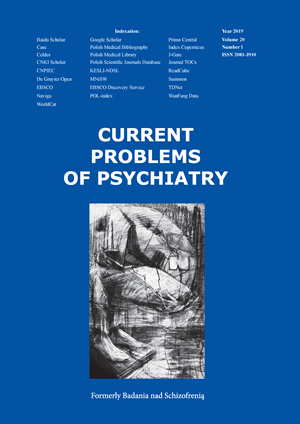Czy zastosowanie warenikliny stanowi szansę na poprawienie skuteczności farmakoterapii uzależnienia od nikotyny?
DOI:
https://doi.org/10.2478/cpp-2019-0002Słowa kluczowe:
rzucanie palenia, nikotynowa terapia zastępcza, wareniklina, bupropion, cytyzynaAbstrakt
Wstęp: Palenie papierosów jest ogromnym problemem medycznym i społecznym w Polsce, ponieważ około 24% Polaków uzależnionych jest od nikotyny. Szacunkowo 6 milionów ludzi na świecie umiera rocznie z powodu chorób, które pozostają w ścisłym związku z nałogiem – takich jak nowotwory, choroby układu krążenia, choroby metaboliczne czy choroby płuc. Trudność w przezwyciężeniu nałogu jest spowodowana w znacznej mierze złożonym mechanizmem uzależnienia. Ogromne znaczenie w trudnym procesie wychodzenia z nałogu ma motywacja pacjenta do porzucenia palenia. Wzmacnianie tej motywacji jest jednym z najistotniejszych zadań lekarzy wielu specjalności i terapeutów uzależnień.
Omówienie danych z literatury: Najszerzej poznanym farmakologicznym sposobem wspomagania wychodzenia z nałogu palenia papierosów od wielu lat pozostaje nikotynowa terapia zastępcza (NRT). Polega ona na dostarczeniu nikotyny do organizmu w sposób mniej szkodliwy niż poprzez dym tytoniowy. W konsekwencji zmniejsza się potrzeba palenia papierosów, co prowadzić ma do powstania korzystnych warunków do całkowitego zerwania z nałogiem. Badania kliniczne wykazały, że stosowanie NRT wiąże się ze zwiększoną o 50-70% szansą na utrzymanie abstynencji od palenia tytoniu w porównaniu z placebo. Istnieje wiele metod przyjmowania terapii zastępczej, są to gumy do żucia z nikotyną, plastry nikotynowe, pastylki do ssania, listki rozpuszczalne w jamie ustnej czy inhalatory. Bupropion to selektywny inhibitor wychwytu zwrotnego dopaminy i noradrenaliny. Lek ten jest jednym z najczęściej stosowanych w farmakoterapii depresji w Stanach Zjednoczonych. Jednocześnie dostrzeżono jego pozytywny wpływ na osoby, próbujące zerwać z nałogiem palenia papierosów. Mechanizm działania pozostaje w tym przypadku nieznany, jednak badania wskazują jednoznacznie na skuteczność bupropionu, która jest porównywalna ze skutecznością NRT. Wareniklina jest selektywnym, częściowym agonistą acetylocholinergicznych receptorów nikotynowych α4β2. Substancja ta ma wyższe powinowactwo do tych receptorów niż nikotyna. Pobudzając je powoduje wzrost wydzielania dopaminy, lecz w niższym stopniu niż w przypadku palenia papierosów, co powoduje zmniejszenie abstynencyjnych objawów odstawienia.
Wnioski: Wareniklina wykazuje wyższą skuteczność niż bupropion i poszczególne formy NRT. Przyjmowanie NRT w dwóch formach równocześnie powoduje wzrost skuteczności tej metody do poziomu porównywalnego z warenikliną. Wbrew wcześniejszym doniesieniom, wydaje się, że wareniklina nie wzmaga zachowań autoagresywnych i nie zwiększa ryzyka samobójstwa.Skuteczność leków zależy od płci pacjenta. Dla obu płci substancją o największej efektywności jest wareniklina. Jest ona nieco skuteczniejsza w grupie kobiet, podczas gdy NRT i bupropion wykazują większy potencjał terapeutyczny u mężczyzn.
Bibliografia
1. TNS Polska Ogólnopolskie badanie ankietowe na temat postaw wobec palenia tytoniu Sierpień 2015.
2. World Health Organization. WHO REPORT ON THE GLOBAL TOBACCO EPIDEMIC: Raising taxes on tobacco 2015.
3. Henningfield JE Keenan RM. Nicotine delivery kinetics and abuse liability. J. Consult. Clin. Psychol. 1993; 61(5): 743-750.
4. Hooper MW Antoni MH Okuyemi K Dietz NA Resnicow K. Randomized Controlled Trial of Group-Based Culturally Specific Cognitive Behavioral Therapy among African American Smokers. Nicotine Tob Res. 2017; 19(3): 333-341.
5. Morell F. MOR A-Therapie – patienteneigene und Farblichtschwingungen. Heidelberg Haug. German 1987.
6. Pihtili A Galle M Cuhadaroglu C Kilicaslan Z Issever H Erkan F Cagatay T Gulbaran Z. Evidence for the Efficacy of a Bioresonance Method in Smoking Cessation: A Pilot Study. Forsch Komplementmed. 2014; 21:239-245.
7. Kostowski W. Współczesna farmakoterapia uzależnienia od nikotyny. Alkoholizm i Narkomania. 2001; 14(1): 129-136.
8. Stead LF Perera R Bullen C Mant D Hartmann-Boyce J Cahill K. et al. Nicotine replacement therapy for smoking cessation. Cochrane Database Syst Rev. 2012; DOI: 10.1002/14651858.CD000146.pub4
9. Hajek P West R Foulds J Nilsson F Burrows S Meadow A. Randomized comparative trial of nicotine polacrilex a transdermal patch nasal spray and an inhaler. Arch. Intern. Med. 1999; 159: 2033-2038.
10. Beard E Shahab L Cummings DM Michie S West R. New Pharmacological Agents to Aid Smoking Cessation and Tobacco Harm Reduction: What Has Been Investigated and What Is in the Pipeline? 2016; 30(10): 951-983.
11. Schnoll RA Goelz PM Veluz-Wilkins A Blazekovic S Powers L Leone FT. et al. Long-term nicotine replacement therapy: a randomized clinical trial. JAMA Intern Med. 2015; 175(4): 504-511.
12. Prochaska JJ. Nicotine Replacement Therapy as a Maintenance Treatment. JAMA. 2015; 314(7): 718–719.
13. A clinical practice guideline for treating tobacco use and dependence: A US Public Health Service report. JAMA. 2000; 283(24): 3244-3254.
14. Bowker KA. Lewis S Coleman T Vaz LR Cooper S. Comparison of cotinine levels in pregnant women while smoking and when using nicotine replacement therapy. Nicotine Tob Res. 2014; 16(6): 895-898.
15. Forinash AB Pitlick JM Clark K Alstat V. Nicotine replacement therapy effect on pregnancy outcomes. Ann Pharmacother. 2010; 44(11): 1817-1821.
16. Scherphof CS van den Eijnden RJ Engels RC Vollebergh WA. Long-term efficacy of nicotine replacement therapy for smoking cessation in adolescents: a randomized controlled trial. Drug Alcohol Depend. 2014; 140: 217-220.
17. Moore D Aveyard P Connock M Wang D Fry-Smith A Barton P. Effectiveness and safety of nicotine replacement therapy assisted reduction to stop smoking: systematic review and meta-analysis. BMJ. 2009; 338: 867-871.
18. Stapleton J West R Hajek P Wheeler J Vangeli E Abdi Z. et al. Randomized trial of nicotine replacement therapy (NRT) bupropion and NRT plus bupropion for smoking cessation: effectiveness in clinical practice. Addiction. 2013; 108(12): 2193–2201.
19. Hughes JR Stead LF Lancaster T. Antidepressants for smoking cessation. Cochrane Database Syst Rev. 2014; 1. DOI: 10.1002/14651858.CD000031.pub3
20. Hurt RD Sachs DP Glover ED Offord KP Johnston JA Dale LC. et al. A comparison of sustained-release bupropion and placebo for smoking cessation. N Engl J Med. 1997; 337: 1195-1202.
21. Richmond R Zwar N. Review of bupropion for smoking cessation. Drug Alcohol Rev. June 2003;22(2):203-220.
22. De Long N Hyslop JR Nicholson CJ Morrison KM Gerstein HC Holloway AC. Postnatal metabolic and reproductive consequences of fetal and neonatal exposure to the smoking cessation drug bupropion. Reprod Sci. 2013; 20(10): 1156-1161.
23. Kautiainen K Ekroos H Puhakka M Liira H Laine J Linden K. et al. Retreatment with varenicline is a cost-effective aid for smoking cessation. J Med Econ. 2017; 20(3): 246-252.
24. Coe JW Brooks PR Vetelino MG Wirtz MC Arnold EP Huang J. et al. Varenicline: an α4β2 nicotinic receptor partial agonist for smoking cessation. J Med Chem. 2005; 48(10): 3474-7.
25. Hajek P McRobbie HJ Myers KE Stapleton J Dhanji AR. Use of varenicline for 4 weeks before quitting smoking: decrease in ad lib smoking and increase in smoking cessation rates. Arch Intern Med. 2011; 171(8): 770-777.
26. Gonzales D Hajek P Pliamm L Nackaerts K Tseng LJ McRae TD. et al. Retreatment With Varenicline for Smoking Cessation in Smokers Who Have Previously Taken Varenicline: A Randomized Placebo-Controlled Trial. Clin Pharmacol Ther. 2014; 96(3): 390-396.
27. Chantix® [package insert]. New York NY: Pfizer Labs 2014.
28. Tabex® [package insert]. Sofia Bulgaria: Sopharma AD 2016.
29. Vinnikov D Brimkulov N Burjubaeva A. A double-blind randomized placebo-controlled trial of cytisine for smoking cessation in medium-dependent workers. The Journal of Smoking Cessation. 2008; 3(01): 57-62.
30. West R Zatonski W Cedzynska M Lewandowska D Pazik J Aveyard P. et al. Placebo-Controlled Trial of Cytisine for Smoking Cessation. N Engl J Med. 2011; 365(13): 1193-1200.
31. Zhuang Y Cummins SE Sun JY Zhu SH. Long-term e-cigarette use and smoking cessation: a longitudinal study with US population. Tobacco Control. 2016; 25: 90-95.
32. Beard E Shahab L Cummings DM Michie S West R. New Pharmacological Agents to Aid Smoking Cessation and Tobacco Harm Reduction: What Has Been Investigated and What Is in the Pipeline? CNS Drugs. 2016; 30(10): 951-83.
33. McRobbie H Bullen C Hartmann-Boyce J Hajek P. Electronic cigarettes for smoking cessation and reduction. Cochrane Database Syst Rev. 2014; 12. DOI: 10.1002/14651858.CD010216.pub2
34. Hughes JR. Stead LF. Lancaster T. Nortriptyline for smoking cessation: a review. Nicotine Tob Res. 2005; 7(4): 491–499.
35. Cinciripini PM Tsoh JY Wetter DW Lam C de Moor C Cinciripini L et al. Combined effects of venlafaxine nicotine replacement and brief counseling on smoking cessation. Exp Clin Psychopharmacol. 2005; 13(4): 282-292.
36. Sarginson JE Killen JD Lazzeroni LC Fortmann SP Ryan HS Ameli N et al. Response to transdermal selegiline smoking cessation therapy and markers in the 15q24 chromosomal region. Nicotine Tob Res. 2015; 17(9): 1126–1133.
37. Gourlay SG Stead LF Benowitz NL. Clonidine for smoking cessation. Cochrane Database Syst Rev. 2004; 3. DOI: 10.1002/14651858.CD000058.pub2
38. Leggio L Zywiak WH Edwards SM Tidey JW Swift RM Kenna GA. A preliminary double-blind placebo controlled randomized study of baclofen effects in alcoholic smokers. Psychopharmacology. 2015; 232(1): 233–243.
39. Oncken C Arias AJ Feinn R Litt M Covault J Sofuoglu M et al. Topiramate for smoking cessation: a randomized placebocontrolled pilot study. Nicotine Tob Res. 2014; 16(3): 288–296.
40. Cahill K Stevens S Perera R Lancaster T. Pharmacological interventions for smoking cessation: an overview and network meta-analysis. Cochrane Database Syst Rev. 2013. Doi: 10.1002/14651858.CD009329.pub2
41. Ebbert JO Hatsukami DK Croghan IT Schroeder DR Allen SS Hays JT et al. Combination varenicline and bupropion SR for tobacco-dependence treatment in cigarette smokers: a randomized trial. JAMA. 2014; 311(2): 155-163.
42. Ramon JM Morchon S Baena A Masuet-Aumatell C. Combining varenicline and nicotine patches: a randomized controlled trial study in smoking cessation. BMC Medicine. 2014; 12: 172.
43. Koegelenberg CF Noor F Bateman ED van Zyl-Smit R.N Bruning A O’Brien JA et al. Efficacy of varenicline combined with nicotine replacement therapy vs varenicline alone for smoking cessation: a randomized clinical trial. JAMA. 2014; 312(2): 155-161.
44. Cahill K Stevens S Perera R Lancaster T. Pharmacological interventions for smoking cessation: an overview and network meta-analysis. Cochrane Database of Systematic Reviews. 2013; 5. DOI: 10.1002/14651858.CD009329.pub2
45. Wetter DW Cofta-Gunn L Fouladi RT Cinciripini PM Sui D Gritz ER. Late relapse/sustained abstinence among former smokers: a longitudinal study. Prev Med. 2004; 39: 1156-1163.
46. Krall EA Garvey AJ Garcia RI. Smoking relapse after 2 years of abstinence: findings from the VA Normative Aging Study. Nicotine Tob Res. 2002; 4 (1): 95-100.
47. Smith P Weinberger A Zhang J Emme E Mazure C McKee S. Sex Differences in Smoking Cessation Pharmacotherapy Comparative Efficacy: A Network Meta-analysis. Nicotine and Tobacco Research. 2017; 19(3): 273-281.
48. Hughes JR. Varenicline as a Cause of Suicidal Outcomes Nicotine & Tobacco Research. 2015; 18(1): 2-9.
49. Tadrous M Martins D Yao Z Mamdani MM Juurlink DN Gomes T et al. Varenicline and Risk of Self-Harm: A Nested Case-Control Study. PLoS One. 2016; 11(9). DOI: 10.1371/journal.pone.0163681
50. Zyban® [package insert]. Greenville SC: GlaxoSmithKline 2011.
51. Steensland P Simms JA Holgate J Richards JK Bartlett SE Varenicline an alpha4beta2 nicotinic acetylcholine receptor partial agonist selectively decreases ethanol consumption and seeking. Proc. Natl. Acad. 2007; 104(30): 12518-12523.
52. Wouda JA Riga D De Vries W Stegeman M van Mourik Y Schetters D et al. Varenicline attenuates cue-induced relapse to alcohol but not nicotine seeking while reducing inhibitory response control Psychopharmacology. 2011; 216 (2): 267-277
53. Kaminski BJ Weerts EM. The effects of varenicline on alcohol seeking and self-administration in baboons Alcohol. Clin. Exp. Res. 2014; 38 (2): 376-383.
54. Jorenby DE1 Hays JT Rigotti NA Azoulay S Watsky EJ Williams KE Billing CB Gong J Reeves KR; Varenicline Phase 3 Study Group. Efficacy of varenicline an alpha4beta2 nicotinic acetylcholine receptor partial agonist vs placebo or sustained-release bupropion for smoking cessation: a randomized controlled trial. JAMA. 2006; 296: 56.
55. Gonzales D Rennard SI Nides M Oncken C Azoulay S Billing CB Watsky EJ Gong J Williams KE Reeves KR; Varenicline Phase 3 Study Group. Varenicline an alpha4beta2 nicotinic acetylcholine receptor partial agonist vs sustained-release bupropion and placebo for smoking cessation: a randomized controlled trial. JAMA. 2006; 296: 47.
Pobrania
Opublikowane
Numer
Dział
Licencja
Prawa autorskie (c) 2019 Autorzy

Praca jest udostępniana na licencji Creative Commons Attribution-NonCommercial-NoDerivatives 3.0 Unported License.


